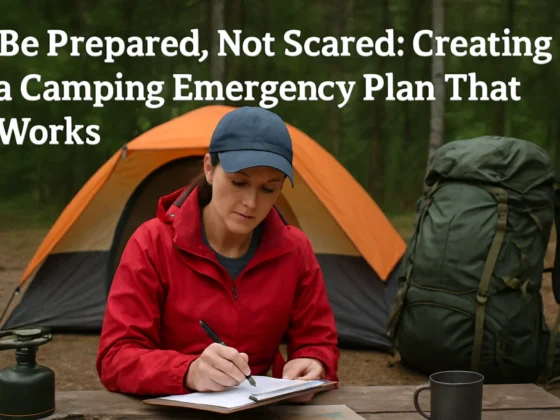Rain is part of the camping experience, especially in the Philippines, where sudden downpours can interrupt even the most meticulously planned trips. But while wet shoes or soggy tents can be tolerated, soaked electronics are a different story.
From phones and GPS trackers to headlamps and portable chargers, modern campers depend on tech to navigate, communicate, and power their essentials. Losing any of these devices to moisture can mean more than just inconvenience—it can put your safety at risk.
This guide offers practical, proven ways to waterproof your electronics, with a focus on smart packing, essential gear, and best practices before and during your rainy-day hikes. Whether you’re exploring a misty trail in Rizal or hunkering down during a thunderstorm in Batangas, keeping your gear dry is a non-negotiable.
Electronics That Need Waterproofing
It’s tempting to think only phones or cameras need protection from the rain. But a quick inventory reveals just how much tech we rely on in the wild.
-
Smartphones
-
GPS devices
-
Smartwatches and altimeters
-
Headlamps and flashlights
-
Power banks and solar chargers
-
Bluetooth speakers
-
Rechargeable battery packs
-
Drones or action cams
Each of these has one weak point in common: water. Once moisture seeps in, corrosion, malfunction, or total failure usually follow.
Waterproof vs. Water-Resistant: Know the Difference
Not all “weatherproof” claims are created equal. Before assuming your device is safe, check its IP rating—a standardized code that measures water and dust protection.
-
IPX4: Splash-proof; handles light rain or sweat.
-
IPX5–IPX6: Can handle jets of water or short rain bursts.
-
IPX7: Submersible up to 1 meter for 30 minutes.
-
IPX8: Designed for extended submersion.
If your gear isn’t rated IPX7 or above, it’s best to take extra waterproofing steps—especially in areas where weather can change rapidly.
Essential Waterproofing Gear to Pack
Here’s what experienced campers always carry to keep their electronics dry, even in tropical downpours:
1. Dry Bags
The gold standard in waterproof storage. Dry bags come in various sizes and are perfect for storing phones, power banks, and cables. Roll-top closures keep water out even if the bag is submerged.
2. Zippered Waterproof Pouches
Smaller than dry bags and great for items you need to access more often, like phones or maps. Opt for pouches with transparent windows for touchscreen use.
3. Waterproof Cases for Phones or Tablets
These cases allow you to use your touchscreen while keeping moisture at bay. Some float, which is a bonus when kayaking or trekking near rivers.
4. Silica Gel Packs
Cheap, reusable, and incredibly effective. Toss a few in your electronics storage to absorb ambient moisture.
5. Cable Management Sleeves
Keeps cords organized and dry inside your bag. Prevents tangling, fraying, or accidental soaking.
6. Plastic Zip Bags
Not fancy, but effective in a pinch. Double-bag for added security.
Packing Smart: Where You Put Things Matters
Even the best waterproof case won’t help if your gear is sitting at the bottom of a rain-soaked backpack. Here’s how to pack like a pro:
-
Keep electronics in the middle layer of your pack. This protects them from both direct rain and ground moisture.
-
Separate wet gear (like towels or used clothes) from electronics at all costs.
-
Use internal pack liners. A large waterproof trash bag inside your backpack can add a second layer of defense.
-
Avoid side pockets during rain unless they’re fully sealed or contain non-electronics.
Handling Electronics in Wet Conditions
Some situations require you to take out your phone or GPS even when it’s raining. In these cases:
-
Use one hand for electronics, the other for your umbrella or poncho hood.
-
Tap with the knuckle or use voice commands instead of exposing more of your hand.
-
Dry your hands before handling cables to avoid corrosion or short circuits.
Bonus tip: Label your cords and keep charging ports covered when not in use.
Charging Safely in the Rain
It’s tempting to top up your devices during a break, but never charge electronics in the open if it’s raining. Here’s how to charge safely in wet conditions:
-
Use a water-resistant shelter or tent vestibule as your charging station.
-
Keep charging devices elevated, away from any floor water or puddles.
-
Connect everything before opening a power source, minimizing port exposure.
-
Wipe connectors dry before plugging them in.
One of the most reliable waterproof charging solutions on the market is the Nitecore power bank, known for its rugged design, sealed ports, and shock-resistant housing. Whether you’re topping up a headlamp at camp or recharging a phone on the trail, the Nitecore power bank is designed to withstand the rough realities of Philippine camping.
Post-Rain Protocol: Drying and Maintenance
After a rainy trip, you should give your electronics and accessories a proper check-up:
-
Remove batteries or unplug devices before drying them.
-
Air-dry your gear for several hours in a cool, dry space.
-
Wipe down cables, connectors, and screens with a microfiber cloth.
-
Recharge everything to 100% and test functionality before your next trip.
Even if your devices seem fine, internal moisture buildup can shorten their lifespan. Always dry gear completely before storing.
Tips for Campers During Monsoon Season
For those planning to camp during peak rainy months (June to October), consider these extra precautions:
-
Use a weather-tracking app to monitor storms ahead of time.
-
Choose elevated campsites to avoid water pooling.
-
Create a tent vestibule for gear management in bad weather.
-
Invest in a large tarp for cooking or gear maintenance in the rain.
And always have a contingency plan: know the nearest exit route or shelter if conditions worsen.
Real-Life Scenario: A Test of Preparedness
Imagine this: you’re on a multi-day trek in Mt. Cristobal. On day two, an unexpected storm hits. The trail becomes slick. Your tent is soaked. But your essentials—GPS, flashlight, phone—still work. Why? Because you stored them in a dry bag, elevated off the ground, and used your Nitecore power bank to recharge them overnight without exposing any ports to moisture. What could have been a dangerous turn becomes just a damp story to laugh about later.
Final Thoughts: Gear Lasts When You Care for It
Electronics have become an inseparable part of the modern camper’s toolkit. But nature doesn’t always play nice. If you want your tech to last—not just the trip, but for years of adventures to come—you need to protect it like any other piece of vital gear.
Waterproofing isn’t complicated. It just takes planning, a bit of investment, and a habit of doing things the right way. From sealing pouches to smart charging routines, every little step helps you avoid costly damage and unnecessary stress.
Because when you’re in the great outdoors, soaked socks are fine. A soaked power bank? Not so much.



